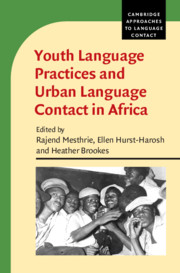Book contents
- Youth Language Practices and Urban Language Contact in Africa
- Cambridge Approaches to Language Contact
- Youth Language Practices and Urban Language Contact in Africa
- Copyright page
- Contents
- Figures
- Tables
- Contributors
- Series Editor’s Foreword
- Preface
- Abbreviations
- Introduction
- 1 Language Contact and Structure in Urban IsiXhosa and Associated Youth Languages
- 2 Not ‘Deep’ but Still IsiXhosa:
- 3 Rethinking Youth Language Practices in South Africa:
- 4 Tsotsitaals, Urban Vernaculars and Contact Linguistics
- 5 Grammatical Hybridity in Camfranglais?
- 6 Sheng and Engsh in Kenya’s Public Spaces and Media
- 7 Exploring Hybridity in Ivorian French and Nouchi
- 8 Authenticity and the Object of Analysis:
- Index
- References
1 - Language Contact and Structure in Urban IsiXhosa and Associated Youth Languages
Published online by Cambridge University Press: 20 August 2021
- Youth Language Practices and Urban Language Contact in Africa
- Cambridge Approaches to Language Contact
- Youth Language Practices and Urban Language Contact in Africa
- Copyright page
- Contents
- Figures
- Tables
- Contributors
- Series Editor’s Foreword
- Preface
- Abbreviations
- Introduction
- 1 Language Contact and Structure in Urban IsiXhosa and Associated Youth Languages
- 2 Not ‘Deep’ but Still IsiXhosa:
- 3 Rethinking Youth Language Practices in South Africa:
- 4 Tsotsitaals, Urban Vernaculars and Contact Linguistics
- 5 Grammatical Hybridity in Camfranglais?
- 6 Sheng and Engsh in Kenya’s Public Spaces and Media
- 7 Exploring Hybridity in Ivorian French and Nouchi
- 8 Authenticity and the Object of Analysis:
- Index
- References
Summary
This chapter explores the role of language contact in the development of linguistic varieties associated with urban youth in South Africa. Youth languages arise out of contexts typically characterised by intense language contact in which code-switching is an integral part of daily speech. The chapter focuses on the mechanism through which linguistic features are blended together in creating the mainstream urban varieties on which youth varieties are based. These varieties display unique features in the lexicon, as well as the apparent grammatical convergence of the languages in the mix. Drawing on theoretical insights from the Matrix Language Frame model and the 4-M model, the chapter analyses data primarily drawn from informal interviews with Tsotsitaal speakers recorded in East London in the Eastern Cape. The chapter seeks to show that although youth languages represent an extreme form of informal speech typified by slang, lexical innovations and manipulations, as well as frequent switching, they have an identifiable structure or grammar, which is not significantly different from the mainstream urban varieties.
- Type
- Chapter
- Information
- Publisher: Cambridge University PressPrint publication year: 2021
References
- 1
- Cited by

